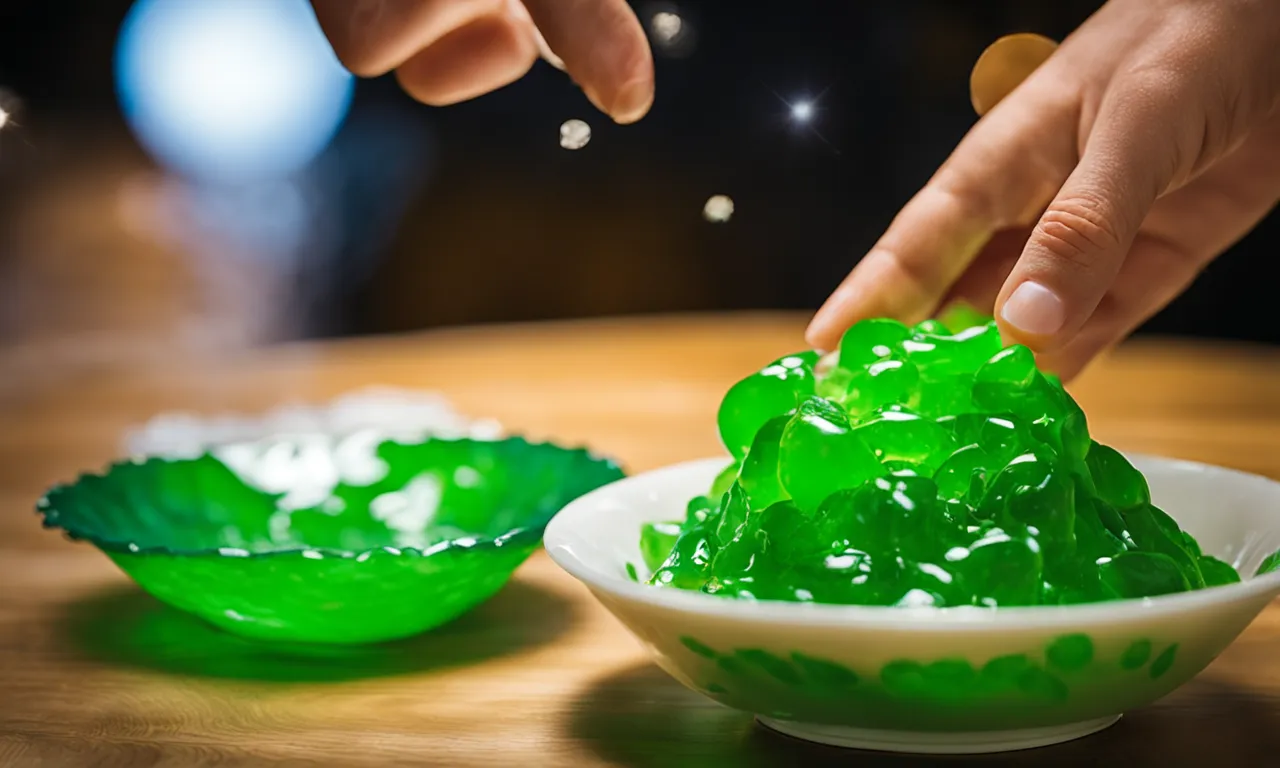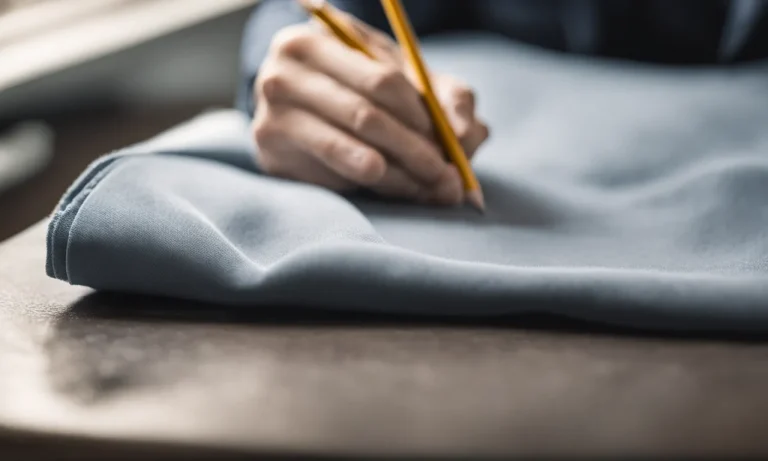How To Remove Dry Slime From Fabric: A Step-By-Step Guide
Is your kid’s shirt covered in crusty, dried slime that just won’t come out? We’ve all been there. Slime is fun to play with, but once it dries on fabric it can be a real pain to remove. If you’re searching for the best way to get dry slime out of clothes, upholstery, and other fabrics, you’ve come to the right place.
If you need a quick solution, try using rubbing alcohol or hand sanitizer to break down the dried glue in slime. Gently rub it into the slime stain before throwing the item in the wash. However, for the most effective methods, read on!
What You’ll Need
When it comes to removing dry slime from fabric, having the right tools and materials is essential. Here are the items you’ll need:
Rubbing alcohol or hand sanitizer
Both rubbing alcohol and hand sanitizer contain isopropyl alcohol, which is effective in breaking down the slime. You can find these products at your local pharmacy or grocery store.
Dish soap
Dish soap is a great option for removing slime stains from fabric. Its grease-cutting properties help to loosen and lift the slime from the fibers.
Washing machine
A washing machine is a convenient and efficient way to clean larger fabric items, such as clothing or bedding, that have been affected by dry slime. Make sure to check the care instructions on the fabric before using the washing machine.
Laundry detergent
Using a laundry detergent specifically designed for stain removal can help to break down and remove the slime from the fabric. Look for a detergent that is suitable for the type of fabric you are cleaning.
Vinegar
Vinegar is a natural cleaning agent that can be used to remove slime from fabric. Its acidic properties help to break down the slime and lift it from the fibers.
Old toothbrush or scrub brush
An old toothbrush or scrub brush can be used to gently scrub the slime and loosen it from the fabric. Make sure to use a soft-bristled brush to avoid damaging the fabric.
Spray bottle filled with water
A spray bottle filled with water can be used to dampen the fabric before applying the cleaning solution. This helps to make the slime easier to remove.
Remember, always follow the care instructions on the fabric and test any cleaning solution on a small, inconspicuous area first to ensure it does not cause any damage.
How to Remove Dried Slime
Accidents happen, especially when it comes to slime. If you find yourself facing a dried slime stain on your favorite fabric, don’t panic! With the right tools and techniques, you can remove it and restore your fabric to its former glory.
Here’s a step-by-step guide to help you tackle dried slime stains effectively.
1. Use Rubbing Alcohol or Hand Sanitizer
One of the easiest ways to remove dried slime from fabric is by using rubbing alcohol or hand sanitizer. Simply apply a small amount of either product directly onto the stain and gently rub it in with a clean cloth or sponge. The alcohol will help break down the slime and make it easier to remove.
2. Make a Detergent Solution
If the slime stain is particularly stubborn, you can create a detergent solution to tackle it. Mix a few drops of liquid laundry detergent with warm water to create a soapy mixture. Apply the solution to the stain and let it sit for a few minutes to loosen the slime.
3. Scrub the Stain
After letting the detergent solution sit for a few minutes, use a soft-bristled brush or an old toothbrush to gently scrub the stain. Be careful not to scrub too hard, as this can damage the fabric. Continue scrubbing until the slime starts to lift from the fabric.
4. Launder as Usual
Once you’ve successfully removed the dried slime, it’s time to launder the fabric as you normally would. Follow the care instructions on the fabric label and wash it accordingly. This will help remove any remaining residue and ensure that the fabric is clean and fresh.
5. Use Vinegar
If the slime stain persists even after laundering, you can try using vinegar. Mix equal parts white vinegar and water, and apply the mixture to the stain. Let it sit for a few minutes before gently scrubbing the stain again.
Vinegar is known for its stain-removing properties and can be effective in tackling tough slime stains.
6. Try Ice
If the dried slime has hardened and is difficult to remove, you can try using ice. Place a few ice cubes in a plastic bag and hold it against the stain for a few minutes. The cold temperature will help harden the slime, making it easier to scrape off with a blunt knife or spoon.
7. Heat it Up
In some cases, applying heat to the dried slime stain can help soften it and make it easier to remove. You can use a hairdryer on a low heat setting to gently warm the area. Be cautious not to overheat the fabric or hold the dryer too close, as this can cause damage.
8. Repeat as Needed
If the slime stain is particularly stubborn, don’t be discouraged. Sometimes, it may take several attempts to completely remove it. Repeat the above steps as needed until the stain is gone.
Remember, it’s always important to test any cleaning solution on a small, inconspicuous area of the fabric before applying it to the stain. This will help ensure that the solution doesn’t cause any damage or discoloration.
With a little patience and the right approach, you can successfully remove dried slime from fabric and restore it to its original condition.
Sources: Good Housekeeping, The Spruce
Tips for Removing Slime
Slime can be a fun and entertaining play material for kids, but it can also be a headache when it ends up on fabrics. Whether it’s on clothing, upholstery, or bedding, removing dry slime from fabric requires a gentle touch and some patience.
Here are some helpful tips to guide you through the process:
Act Fast for Fresh Stains
When dealing with fresh slime stains, it’s important to act quickly. The longer the slime sits on the fabric, the harder it will be to remove. So, as soon as you notice the slime, gently scrape off any excess with a spoon or a blunt knife.
Be careful not to spread the slime further or push it deeper into the fabric.
Check Fabric Care Instructions
Before you begin any cleaning process, always check the fabric care instructions. Different fabrics require different cleaning methods, and using the wrong method could damage the fabric. If the fabric is delicate or dry clean only, it’s best to take it to a professional cleaner.
Avoid the Dryer
One important tip to remember when dealing with slime on fabric is to avoid using the dryer. The heat from the dryer can cause the slime to set further into the fabric, making it even more difficult to remove. Instead, focus on treating the stain and then air drying the fabric.
Use Cold Water
When it comes to removing slime from fabric, cold water is your best friend. Start by rinsing the stained area with cold water to loosen the slime. Avoid using hot water, as it can cause the slime to become stickier and more difficult to remove.
Pretreat Heavily Soiled Areas
If the slime stain is particularly heavy or has been sitting on the fabric for a while, it may require some extra attention. Consider pretreating the stained area with a stain remover or a gentle liquid detergent.
Follow the instructions on the product label and allow the pretreatment to sit for a few minutes before moving on to the next step.
Start with Gentle Cleaning Methods
When it’s time to clean the fabric, start with the gentlest method possible. This could be using a mild soap or a gentle fabric cleaner. Apply a small amount directly to the stain and gently rub it in using a clean cloth or sponge.
Be careful not to scrub too vigorously, as this can damage the fabric fibers.
Use a Soft-Bristled Brush or Toothbrush
If the slime is still not coming off, you can try using a soft-bristled brush or a toothbrush to gently scrub the stain. This can help loosen the slime from the fabric fibers without causing any damage. Remember to always work in a gentle and circular motion.
Rinse Thoroughly After Treatment
After treating the slime stain, be sure to rinse the fabric thoroughly with cold water. This will help remove any remaining cleaning product residue and slime particles. Once rinsed, gently squeeze out any excess water and allow the fabric to air dry.
By following these tips and being patient, you can successfully remove dry slime from fabric without causing any damage. Remember to always test any cleaning product on a small, inconspicuous area first to ensure it doesn’t cause any discoloration or damage to the fabric.
How to Avoid Slime Stains
Play with Slime on a Washable Surface
When it comes to playing with slime, it’s best to choose a washable surface to minimize the risk of stains. Opt for a tablecloth or plastic tray that can easily be wiped down or washed after playtime. This way, any slime residue or spills can be easily cleaned up without leaving a mark on your fabric or carpet.
Have Kids Wear an Apron or Smock
Another way to prevent slime stains is to have children wear an apron or smock while playing with slime. This will protect their clothes from any accidental spills or splatters. Not only will it keep their outfits clean, but it can also add an element of fun to the slime-playing experience.
Set Limits on Where Slime can be Used
To avoid any potential mess, it’s a good idea to set limits on where slime can be used. Designate a specific area or play zone for slime play, such as the kitchen table or a dedicated playroom. This way, you can contain any potential stains to a specific area and minimize the risk of slime coming into contact with delicate fabrics.
Store Slime in Sealable Containers
Proper slime storage is essential to prevent accidental spills or leaks that can lead to stains. Make sure to store slime in sealable containers to keep it contained and avoid any mishaps. This will not only help preserve the slime’s texture and prevent it from drying out but also minimize the chances of it coming into contact with fabrics.
Opt for Less-Staining Slime Recipes
Not all slime recipes are created equal when it comes to potential stains. Some slime recipes are known to be more staining than others. If you’re concerned about fabric stains, consider opting for less-staining slime recipes.
There are many recipes available online that use ingredients that are less likely to leave permanent marks on fabric.
By following these tips, you can enjoy the fun and sensory experience of playing with slime while minimizing the risk of stains on your fabrics. Remember to always supervise children when playing with slime and clean up any spills or residue promptly for best results.
Conclusion
With the right techniques and a little elbow grease, you can successfully remove dried slime from clothing, upholstery, carpets and more. Act quickly when you first notice a slime stain, and be prepared to repeat treatments several times if needed.
The staining agents in slime can be stubborn, but they’re no match for rubbing alcohol, vinegar, detergent and some good old-fashioned scrubbing. With these simple methods, you’ll get those pesky slime stains out in no time.







